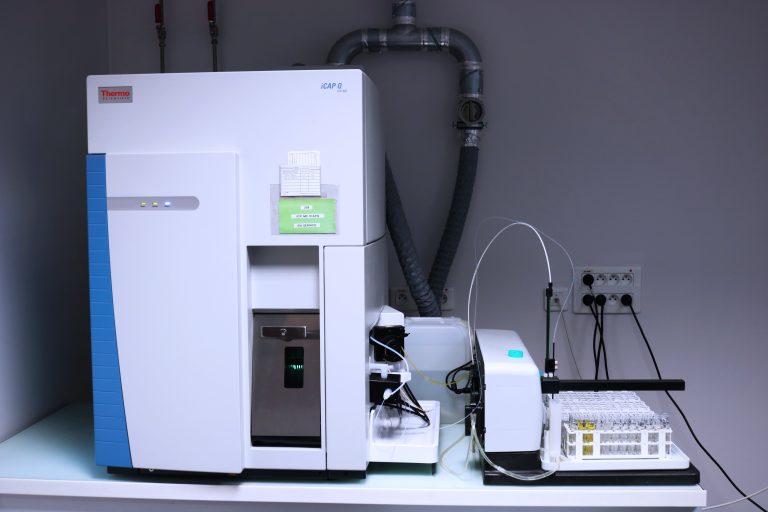What is an ICP-MS analysis?
First of all, the acronym ICP stands for “Inductively Coupled Plasma“. ICP is an inductively coupled plasma analytical technique for measuring the content of an inorganic element in a sample. This technique is applicable to all types of elemental chemicals.
The analysis of samples by ICP takes place in several steps. First, the solid sample is put into solution using a strong acid or by microwave. This is called mineralization. The preparation is then introduced by vaporization in argon plasma at very high temperature. These thermal excitations lead to ionization and separation of the elements, thus making it possible to characterize and detect each element using MS.
The acronym MS stands for Mass Spectrometry. Mass spectrometry is an analytical technique to determine the molecular weight of molecules in a substance to determine their nature. Used in many scientific activities, it is known for its fast detection time and its accuracy of <1 ppm.
The combined use of ICP and MS allows the detection of a wide range of inorganic elements and elemental impurities, in a single run, with extreme reliability and accuracy (in the ppt to ppb range depending on the matrices).
The FILAB laboratory has about fifteen ICPs.

Our services
Confirm the chemical composition of a mixture
Characterize an unknown deposition
Check the conformity of a formula or a material with respect to a regulation
Deform a product to compare its chemical composition
Detect traces of heavy metals (As, Pb, Cd, Hg...)
Search for an elementary impurity at the origin of a defect or a failure
Analysis of poor metals : aluminium, thalium, indium...
Registering a new mineral material in the context of dual sourcing
our expertise and trainings
Train your teams (on site or remotely)
Transfer the methods to your laboratories
Validate protocols according to guidelines
What is ICP-MS used for?
Inductively Coupled Plasma Mass Spectrometry (ICP-MS) is a powerful analytical technique used for the quantitative and qualitative analysis of elements in various types of samples. It is known for its exceptional sensitivity, accuracy, and ability to detect a wide range of elements at trace levels. Here are some common applications of ICP-MS:
- Pharmaceuticals and Life Sciences:
- Quantification of trace elements in pharmaceutical products to ensure quality and compliance with regulatory standards.
- Metallurgy and Materials Science:
- Analysis of metals, alloys, and materials to determine elemental composition, trace impurities, and quality control in manufacturing processes.
- Nuclear Industry:
- Monitoring and analysis of nuclear materials and radioactive isotopes in nuclear facilities.
- Quality Control and Manufacturing:
- Elemental analysis of various industrial products, including electronics, ceramics, and chemicals, to ensure product quality and compliance with industry standards.
- Waste Characterization:
- Assessment of elemental composition in waste materials for disposal and recycling purposes.
- Petroleum and Petrochemical Industry:
- Analysis of crude oil and petroleum products for trace metal impurities and environmental compliance.
ICP-MS is highly versatile and can analyze a wide range of elements across the periodic table, from alkali metals to lanthanides and actinides, often down to parts per trillion (ppt) or even parts per quadrillion (ppq) levels. This makes it an essential tool in various scientific, industrial, and environmental applications where accurate and sensitive elemental analysis is required.
What is the process for an ICP-MS analysis?
The first step is to prepare the sample. This may involve digestion (breaking down solid samples into a solution), dilution, filtration, or any other necessary pre-treatment to ensure that the sample is in a suitable form for analysis.
The prepared sample is then introduced into the ICP-MS instrument. There are different methods for sample introduction, including nebulization, where the sample is converted into a fine aerosol, or direct injection for liquid samples. Solid samples may be dissolved before introduction.
The sample aerosol is introduced into an ICP torch, which consists of a high-temperature argon plasma. In the plasma, the sample is vaporized, atomized, and ionized. The high temperatures (around 10,000°C) in the ICP ensure that the sample is completely atomized and converted into ions.
After ionization, the ions are extracted from the plasma and directed into a mass spectrometer. The mass spectrometer consists of three main components: the mass analyzer, the ion detector, and the data acquisition system.
The mass analyzer separates ions based on their mass-to-charge ratio (m/z). It allows only ions of a specific mass-to-charge ratio to pass through at any given moment.
The ions that pass through the mass analyzer are detected by an ion detector, typically a detector array called a detector array, such as a time-of-flight (TOF) detector or a quadrupole detector.
The ion detector records the number of ions detected at each m/z value, creating a mass spectrum. The mass spectrum obtained from the ion detector is processed and analyzed using specialized software. The software identifies the peaks in the spectrum, which correspond to different elements in the sample. It also quantifies the concentration of each element based on the intensity of the corresponding peaks in the mass spectrum. This is often done by comparing the sample’s signal to that of known standards or calibration curves.
The results of the analysis, including the concentrations of elements in the sample, are reported to the user. The report may also include any necessary quality control information to ensure the reliability of the data.








